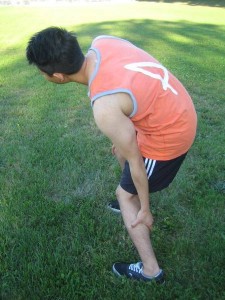A thigh cramp can occur while engaging in sports. Muscle cramps are involuntary movements or contractions of the muscles. These cramps cause agonizing pain and disable the affected muscles until they disappear. It usually affects the front and back area of the thigh particularly the hamstrings and quadriceps.
The cramps can be caused by poor blood circulation and fatigue of muscles, dehydration, deficiency in potassium or magnesium and a pinched nerve. Sometimes, a thigh cramp can be caused by deficiencies in minerals. Medical conditions that can cause thigh cramps include Parkinson’s disease, pregnancy, alcoholism, neuromuscular disorders and endocrine disorders such as diabetes.
Treatment
- Massage the area of the thigh where the muscle is cramping. Press the affected area gently using the hands and apply pressure as long as it does not cause pain. Massage increases circulation of blood in the area. Stretching combined with massage lessens the pain of a thigh cramp and relaxes the body.
- Another way is using a foam roller in massaging the thighs. Roll in a circular manner on the affected thigh by applying pressure.
Take the prescribed over-the-counter pain medication and muscle relaxant such to relieve tightness and cramping of the muscles. - Apply heat on the affected area to relax the contraction of the muscles and lessen the pain and tension of the muscles. The individual can also take warm baths. The heat promotes proper circulation of blood to the submerged area. Another alternative is adding Epsom salts in the warm bath since it relieves a thigh cramp. Hot water bottles or a heating pad can be applied on the area as well. Apply an over-the-counter heat rub can also lessen the muscle cramps and relax the affected area.
- Increase the consumption of potassium and calcium rich foods to minimize muscle cramps. Foods rich in potassion and calcium such as oranges and bananas for potassium, almonds, brown rice and avocados for magnesium. Milk, yogurt and other dairy products are ideal sources of calcium. Another alternative is taking a multi-mineral supplement.
- Drink plenty of water to avoid dehydration and an ensuing thigh cramp. Drink sports drinks or juices throughout the day.
- Avoid sleeping on a tightly made bed and sleeping in a position such as on the stomach to avoid thigh cramps. Flat sheets constrict movement of the legs and feet. Sleep on one side with the knees slightly bend and the toes are pointing downward to lessen episodes of muscle cramps in the thigh.
- Take the prescribed over-the-counter pain medication and muscle relaxant such to relieve tightness and cramping of the muscles.
Tip
- Seek medical help about a recurring thigh cramp since it can be a sign of injury, dehydration or nutrient deficiency.
- If a thigh cramp occurs when performing workouts or any strenuous activity, stretch the muscle and rest for a while and massage the affected area.
Disclaimer
The material posted on this page for a thigh cramp is for learning purposes only. If you want to learn to manage muscle conditions including a thigh cramp, register for a first aid course with a training provider near you.

